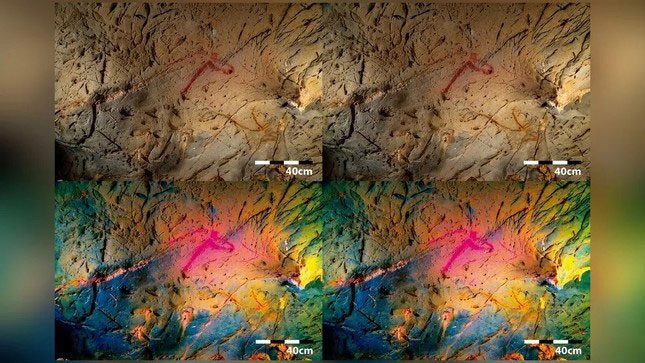Using a unique method that dates back centuries, researchers have uncovered hidden animal figures on the walls of a cave in Spain. This technique, known as stereophotography, has existed since the early 1800s but is perhaps best known for its use in the View-Master, a VR preview device beloved by generations of children.
After examining the contours of the cave wall, researchers employed 3D techniques to reveal rock art depicting a horse. The two images below were processed using DStretch computer software.

Animals revealed on the walls of a cave in Spain using “Magic Eye” technique. (Image: R. Asiain & P. Saura; Antiquity Publications, Ltd.)
Cave art is a renowned and ancient artistic medium in Europe, dating back at least 40,000 years. Although archaeologists have studied this ancient art form for over a century, their focus has often been on two-dimensional designs, relying on sketches, traces, and photographs to document the artwork.
Recently, 3D recording and viewing methods have gained popularity in archaeology. These methods capture more artistic details in rock art than traditional 2D techniques, yet they are still frequently viewed and studied as 2D images on computer screens, which is not how the creators of the artwork intended it to be seen.
A new study, published on August 17 in the journal Antiquity, has changed how archaeologists view cave paintings, featuring stereophotographic images from the La Pasiega cave in northern central Spain.
Raquel Asiain, an archaeologist and photographer at Complutense University of Madrid, along with her colleagues, devised a simple method to capture the three-dimensional nature of the cave walls and the art upon them.
While stereoscopic pairs of images are best viewed through specific equipment, the hidden 3D images can also be detected with the naked eye, similar to the images in the trippy “Magic Eye” designs of the 1990s.
Discovery of Three Extinct Cattle Species
Over 700 depictions of animals, symbols, dots, and lines cover the walls of La Pasiega, first discovered in 1911. However, through systematic research utilizing stereophotography, Asiain and her colleagues uncovered three previously hidden animal species: two horses and one aurochs, a species of extinct cattle.
The horses are easily visible through the high-resolution images that researchers posted on Flickr. Digitally enhanced images reveal one horse beneath the image of a deer in the center, as well as the mane, neck, and chest of another horse on the left. The latter horse is positioned so that its head rests against a concave area of the cave wall, while its chest sits on a convex area, enhancing the three-dimensionality of the animal.
Using 3D glasses, or even just a slight squint, one can easily see the rippling contours of the cave walls, much like someone would have seen tens of thousands of years ago.
Asiain told Live Science in an email: “In Upper Paleolithic cave art, artists utilized the natural shapes of the cave to create their paintings. The need to preserve the 3D perception of caves is one of the reasons that compelled me to use these stereoscopic images.”
With high-quality photography, the images allow researchers to view the artwork in “true” 3D, rather than as a simulation using 3D scans. The publication of these stereoscopic images means the public can experience the art more closely, just as people once did in the past.


















































